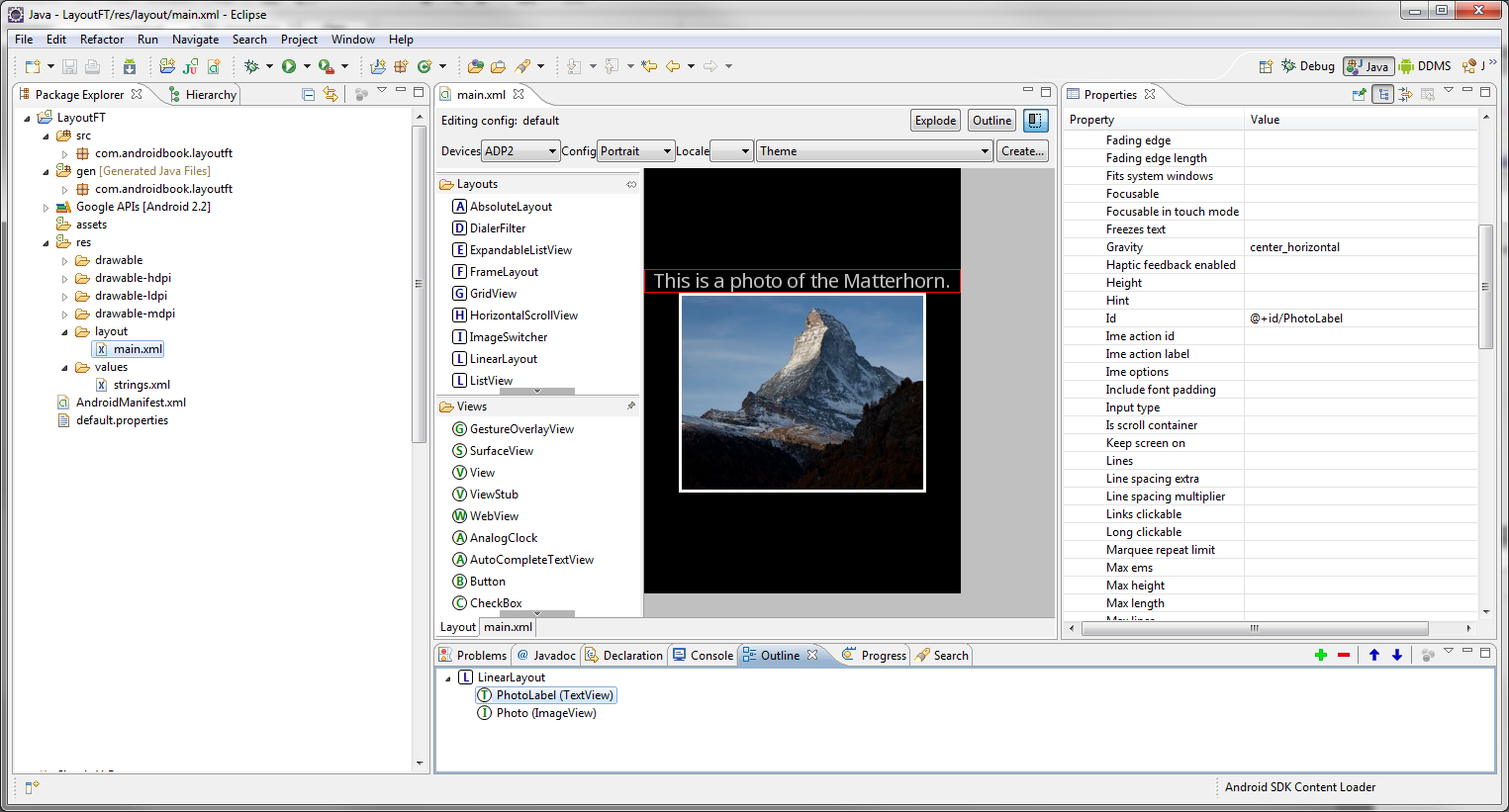Understanding layouts is important for good Android application design. In
this tutorial, we provide an overview of how layouts fit into the
Android application architecture. We also explore some of the specific
layout controls available for organizing application screen content in a
variety of interesting ways.
What Is A Layout?
Android developers use the term layout to mean one of two things.
Both definitions apply to this tutorial, and are, unfortunately used
interchangeably in the Android development community. The two
definitions of layout are:
- A type of resource that defines what is drawn on the screen. Layout
resources are stored as XML files in the /res/layout resource directory
for the application. A layout resource is simply a template for a user
interface screen, or portion of a screen, and contain.
- A type of View class whose primary purpose is to organize other
controls. These layout classes (LinearLayout, RelativeLayout,
TableLayout, etc. ) are used to display child controls, such as text
controls or buttons or images on the screen.
Android user interfaces can be defined as layout resources in XML or created programmatically.
Using Eclipse to Design Layout Resources
The Android Development Plug-in for Eclipse includes a handy layout
resource designer for designing and previewing layout resources. The
tool includes two tab views: the Layout view allows you to preview how
the controls will appear on various screens and for each orientation and
the XML view shows you the XML definition of the resource. The layout
resource designer is shown in this figure:
Here are some tips for working with the layout resource designer in Eclipse:
- Use the Outline pane to Add and Remove controls to your layout resource.
- Select a specific control (either in the Preview or the Outline) and
use the Property pane to adjust a specific control’s attributes.
- Use the XML tab to edit the XML definition directly.
It’s important to remember that the Eclipse layout resource designer
preview can’t replicate exactly how the layout will appear to end users.
For this, you must test your application on a properly configured
emulator and, more importantly, on your target devices. Also, certain
“complex” controls, including tabs or video viewers, cannot be previewed
within Eclipse.
Layouts and XML: The basics
The basic Android approach to layout is to set it up in XML, in a
layout file that is usually found in res/layout/. It's also possible to
then grab and alter that layout information programmatically at runtime
as your app requires. (It's also possible simply to instantiate your
layout information at runtime, but that's less flexible and maintainable
than using XML, and I won't cover it here.)
The structure of an XML layout file is similar to the structure of an
HTML webpage -- you can think of it as a series of nested elements, or
as a tree. Each layout file has one single root element, which must be a
View or ViewGroup element (such as LinearLayout, RelativeLayout,
ListView...). The limitations of the arrangements of the child elements
(panes, buttons, images, text... all the visual parts of your app) will
vary according to the specific root element. Let's look at what we can
do with a LinearLayout.
LinearLayout: The basics
A LinearLayout is a very simple layout that just arranges all its
children in either a vertical column, or a horizontal row, depending on
how it is specified. A vertical LinearLayout will only have one child
per row (so it is a column of single elements), and a horizontal
LinearLayout will only have one single row of elements on the screen.
There are obvious disadvantages to this for more complicated apps -- you
probably don't want all your buttons to line up one under the other,
for example. To set up more complicated arrangements, you'll probably
want to use a RelativeLayout (which we'll look at in another tutorial);
we'll also have a quick look at nesting LinearLayouts at the bottom of
this tutorial.
Here's a basic vertical LinearLayout. Create a new Android project,
LayoutTest, and put this in res/layout/activity_layout_test.xml:
<?xml version="1.0" encoding="utf-8"?>
<LinearLayout xmlns:android="http://schemas.android.com/apk/res/android"
android:layout_width="fill_parent"
android:layout_height="fill_parent"
android:orientation="vertical" >
<TextView
android:layout_width="fill_parent"
android:layout_height="wrap_content"
android:text="@string/hello" />
<EditText
android:layout_width="fill_parent"
android:layout_height="wrap_content"
android:hint="@string/name" />
<Button
android:layout_width="100dp"
android:layout_height="wrap_content"
android:text="@string/setName" />
</LinearLayout>

It's good practice to keep your
strings in a resource file, rather than hard-coding them into your
layout. This makes for easier internationalisation, and is more
maintainable. So you'll also need to edit res/values/strings.xml:
<resources>
<string name="app_name">LayoutTest</string>
<string name="hello">Hello world!</string>
<string name="name">Name</string>
<string name="setName">Set name</string>
</resources>
As you'll see , you can refer to Android string resources with @string/stringname. This is a standard format which we'll see used for other resources in due course.
To make this show up on the screen, you'll also need to edit src/com/example/layouttest/LayoutTestActivity.java:
package com.example.layouttest;
public class LayoutTestActivity extends Activity {
protected void onCreate(Bundle savedInstanceState) {
super.onCreate(savedInstanceState);
setContentView(R.layout.activity_layout_test);
}
}
Run this (on your phone or on the emulator), and you should get a
layout like the one at left. All three elements are laid out one under
the other.



















